Treatment and Conditioning of Nuclear Waste
- Before disposal, nuclear waste needs to be in solid form and resistant to leaching.
- Packaging should be appropriate to the waste and its disposal.
- High-activity waste requires shielding.
Treatment and conditioning processes are used to convert a wide variety of radioactive waste materials into forms that are suitable for their subsequent management, including transportation, storage and final disposal. The principal aims are to:
- Minimize the volume of waste requiring management via treatment processes.
- Reduce the potential hazard of the waste by conditioning it into a stable solid form that immobilizes it and provides containment.
It is important to note that, while treatment processes such as compaction and incineration reduce the volume of waste, the amount of radioactivity remains the same. As such, the radioactivity of the waste will become more concentrated as the volume is reduced.
The choice of process(es) used is dependent on the level of activity and the type (classification) of waste. Each country's nuclear waste management policy and its national regulations also influence the approach taken.
Conditioning processes such as cementation and vitrification are used to convert waste into a stable solid form that is insoluble and will prevent dispersion to the surrounding environment. A systematic approach typically incorporates:
- Identifying a suitable matrix material – such as cement, bitumen, polymers or borosilicate glass – that will ensure stability of the radioactive materials for the period necessary. The type of waste being conditioned determines the choice of matrix material and packaging.
- Immobilizing the waste through mixing with the matrix material.
- Packaging the immobilized waste in, for example, metal drums, metal or concrete boxes or containers, or copper canisters.
A more sophisticated approach is incorporating the particular waste into the crystal structure of natural minerals which are geochemically stable (see Synroc and composite wasteforms section below).
High-level waste (HLW) is the main focus of attention, though it comprises only about one percent of all radioactive waste by volume. The main scope for volume reduction is within low-level waste (LLW) and intermediate-level waste (ILW). Both ILW and HLW require shielding, so the handling and conditioning may be in hot cells of various kinds to provide that.
Incineration and compaction
Incineration
The combustible elements of both radioactive and other wastes can be incinerated to reduce volume. The incineration of many kinds of hazardous waste (e.g. waste oils, solvents) and non-hazardous waste (e.g. municipal waste, biomass, tyres, sewage sludge) is practised in many countries, subject to emission limits.
In the case of radioactive waste, it has been used for the treatment of LLW from nuclear power plants, fuel production facilities, research centres (such as biomedical research), the medical sector, and waste treatment facilities.
Following the separation of non-combustible constituents, the waste is incinerated in a specially engineered kiln at temperatures up to around 1000oC. The gases and fumes produced during incineration are treated and filtered prior to emission into the atmosphere, and emissions must conform to international standards and national regulations. After incineration, the resulting ash, which contains the radionuclides, may require further conditioning, such as cementation or bituminization, prior to disposal. Compaction may also be used to further reduce the volume, if this is deemed to be cost-effective. Overall volume reduction factors of up to around 100 are achieved, primarily for LLW, depending on the density of the waste.
Compaction
Compaction is a straightforward means of reducing waste volumes and is used for processing mainly solid industrial LLW. Some countries (Germany, UK, and USA) also use the technology for the volume reduction of ILW and transuranic waste. Compactors can range from low-force compaction systems (~5 tonnes) through to presses with a compaction force over 1000 tonnes, referred to as supercompactors. Volume reduction factors are typically between 3 and 10, depending on the waste material being treated.
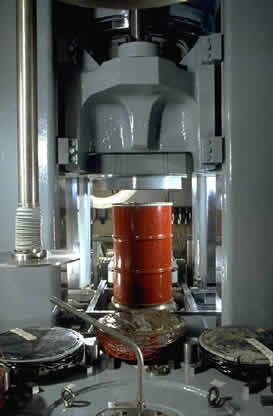
Low-force compaction is typically applied to the compression of bags of rubbish, in order to facilitate packaging for transport either to a waste treatment facility, where further compaction might be carried out, or to a storage/disposal facility. In the case of supercompactors, in some applications, waste is sorted into combustible and non-combustible materials. Combustible waste is then incinerated whilst non-combustible waste is supercompacted. In certain cases, incinerator ashes are also supercompacted in order to achieve the maximum volume reduction before secure containment.
Low-force compaction utilizes a hydraulic or pneumatic press to compress waste into a suitable container, such as a 200-litre drum for transport either to a waste treatment facility, where further compaction might be carried out, or to a storage/disposal facility. Other wastes including incinerator ash may be supercompacted before storage or disposal. Here a large hydraulic press crushes a drum or other receptacle containing various forms of solid low- or intermediate-level waste (LLW or ILW). The resulting pellets are then sealed inside an overpack container for interim storage and/or final disposal.
Supercompaction systems may be mobile or stationary, and have a significant range of complexity. An elaborate computer controlled system might be used to select drums to be processed, measure weight and radiation levels, compress the drums, place the crushed drums in overpack containers, seal the overpacks, and record the content of the drums' and overpacks' via a computerized storage system.
The 1800-tonne force supercompactor at Idaho Advanced Mixed Waste Treatment Project (AMWTP) has achieved 100,000 hours operation in compacting some 238,000 drums, each 200-litres, of military transuranic waste into one-fifth that volume before trucking for disposal at the Waste Isolation Pilot Plant (WIPP) in New Mexico.
Cementation
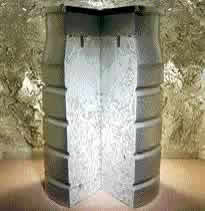
Cementation through the use of specially formulated grouts provides a means to immobilize radioactive material that is in various forms of sludges and precipitates/gels (flocks) or activated materials, as well as fragmented solids.
In general the solid waste is placed into containers. The grout is then added into the container and allowed to set. Sludges and flocks are placed in a container and the grouting mix, in powder form, is added. The two are mixed and left to set. In each case the container with the now monolithic block of concreted waste is then suitable for storage and disposal.
This process has been used, for example, in small oil drums and 500-litre containers for ILW, and has been extended to ISO shipping containers for LLW.
The technology is being used in the immobilization of many toxic and hazardous wastes that arise outside the nuclear industry and has the potential to be used in many more cases. In some cases bitumen is the matrix material.
Vitrification
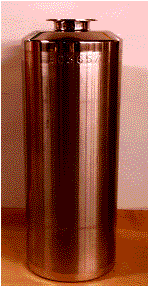
The immobilization of HLW requires the formation of an insoluble, solid waste form that will remain stable for many thousands of years. In general borosilicate glass has been chosen as the medium for dealing with separated HLW. The stability of ancient glass for thousands of years highlights the suitability of borosilicate glass as a matrix material.
This type of process, referred to as vitrificationa, has also been extended for lower level waste where the type of waste or the economics have been appropriate.
Most HLW, other than spent fuel itself, arises in a liquid form from the reprocessing of spent fuel. This HLW comprises highly-radioactive fission products and some transuranic elements with long-lived radioactivity. To allow incorporation into the glass matrix the waste is initially calcined (dried) to a granular powder. The product is then incorporated into molten glass, poured into a robust stainless steel canister about 1.3 metres high, and allowed to cool, forming a solid matrix. The containers are then welded closed and are ready for storage and final disposal.
This process is currently being used in France, Japan, Russia, UK, and USA and is seen as a suitable and adequate process for management of separated HLW arising from reprocessing. The capacity of western European vitrification plants is about 2,500 canisters (1000 t) a year, and some have been operating for three decades.
In-situ vitrification has also been investigated as a means of 'fixing' activity in contaminated ground as well as creating a barrier to prevent further spread of contamination.1
Synroc and composite wasteforms
Synroc is basically a ceramic made from several natural minerals which together incorporate into their crystal structures nearly all of the elements present in HLW, providing a very stable and enduring material for disposal.
The original form was intended mainly for the immobilization of liquid HLW arising from the reprocessing of light water reactor fuel. However, by 1980 those reprocessing used fuel had chosen borosilicate glass as the medium for immobilization because it was the most technically mature technology. Over the past few years, different forms of Synroc have been developed to deal with wastes for which there is no current disposition route, particularly military radioactive waste.
Synroc wasteforms are tailored to suit the characteristics of the particular nuclear waste to be immobilized, rather than adopting a single one-size-fits-all approach.
The Synroc process involves hot isostatic pressing at over 1200°C and 150 MPa. In a hot cell, the radioactive liquid waste is mixed with additives that create a slurry, which is then dried to produce a free-flowing powder. The granular powder is dispensed into cans where it is sealed. Each can is placed inside a furnace contained within a hot isostatic press (HIP), where heat and pressure are applied to lock in the radionuclides – the powdered mixture fuses together to form a solid without releasing any emissions. The compressed can is a cylindrical shape about two-thirds the original volume.
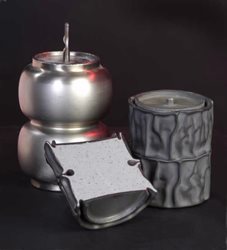
The thin-walled vessel (left) is filled with a granulated waste form powder that is subsequently compressed into a solid mass by hot isostatic pressing. The can is designed to collapse into a cylindrical shaped vessel (right) for storage. The centre of the image shows a cross-section of the dense solid waste form that is encapsulated within the vessel. (Image: Ansto)
At the ANSTO Nuclear Medicine Project in Sydney, the final storage volume with Synroc will be 1% of the same waste cemented for disposal.
Further information in Radioactive Waste Management Appendix 1: Synroc.
Glass-ceramic composites
Glass-ceramic composites which combine the process and chemical flexibility of glass with the superior chemical durability of ceramics have been developed and have achieved very high waste loadings (50-80%). They can be tailored for the particular waste and applied to those which are intractable due to their complex and heterogeneous chemistry.
Engineered encapsulation
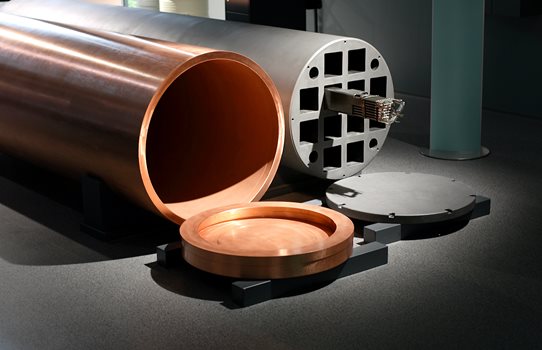
Image: Posiva
Where used fuel is not reprocessed to recycle its useful constituents, after long storage and before disposal it is encapsulated. The fuel itself comprises stable ceramic fuel pellets inside tubes. But before disposal these are put into large metal canisters about five metres long to provide additional containment. Sweden and Finland are using copper canisters with a cast iron or boron steel internal structure, each holding about 12 fuel assemblies.
References
1. An Overview of In Situ Waste Treatment Technologies, S. Walker, R. A. Hyde, R. B. Piper, M. W. Roy, Idaho National Engineering Laboratory, presented at the Spectrum '92 Conference, Boise, Idaho (August 1992). [Back]
Notes
a. See Handbook: Vitrification Technologies for Treatment of Hazardous and Radioactive Waste, United States Environmental Protection Agency, EPA/625/R-92/002 (May 1992), available from the EPA's National Service Center for Environmental Publications. [Back]
Appendices
Radioactive Waste Management Appendix 1: SynrocRelated information
Radioactive Waste ManagementStorage and Disposal of Radioactive Waste